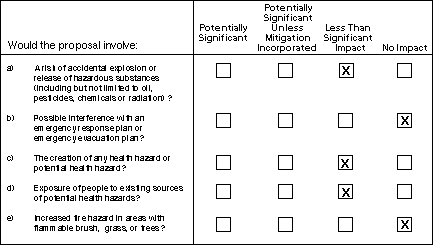
IX. HAZARDS

- raise the transmission line's tubular steel poles or conductors by 10 ft. to reduce EMF at ground level;
- use metal clad switchgear to reduce magnetic field contributions from the 12 kV bus; and,
- use compact equipment spacing, which reduces the site area used and allows equipment to be shifted away from the residential property (Charter Oaks) and provides more distance between the equipment and the property lines in order to reduce magnetic field strength at the property line.
In conclusion, there is no evidence that the existing EMF from the 230 kV Metcalf-Monta Vista transmission line (and the 12 kV distribution line along Winchester Boulevard) presents a health hazard to those individuals who live and/or work in the vicinity of the site. Further, there is no evidence that the additional EMF contributed by the proposed Vasona substation would create a health hazard or potential health hazard. The impact is less than significant and additional mitigation is not required.
Operation of the proposed Vasona substation would decrease the number of people working on or using the site, so the project would not increase the total exposure of people to any existing sources of potential health hazards.
TOP
| Forward to Next Section (Noise) |
Back to Previous Section (Energy and Mineral Resources) |
Back to Vasona Substation Main Page | PG&E Substation Projects Main Page | CPUC Home Page |